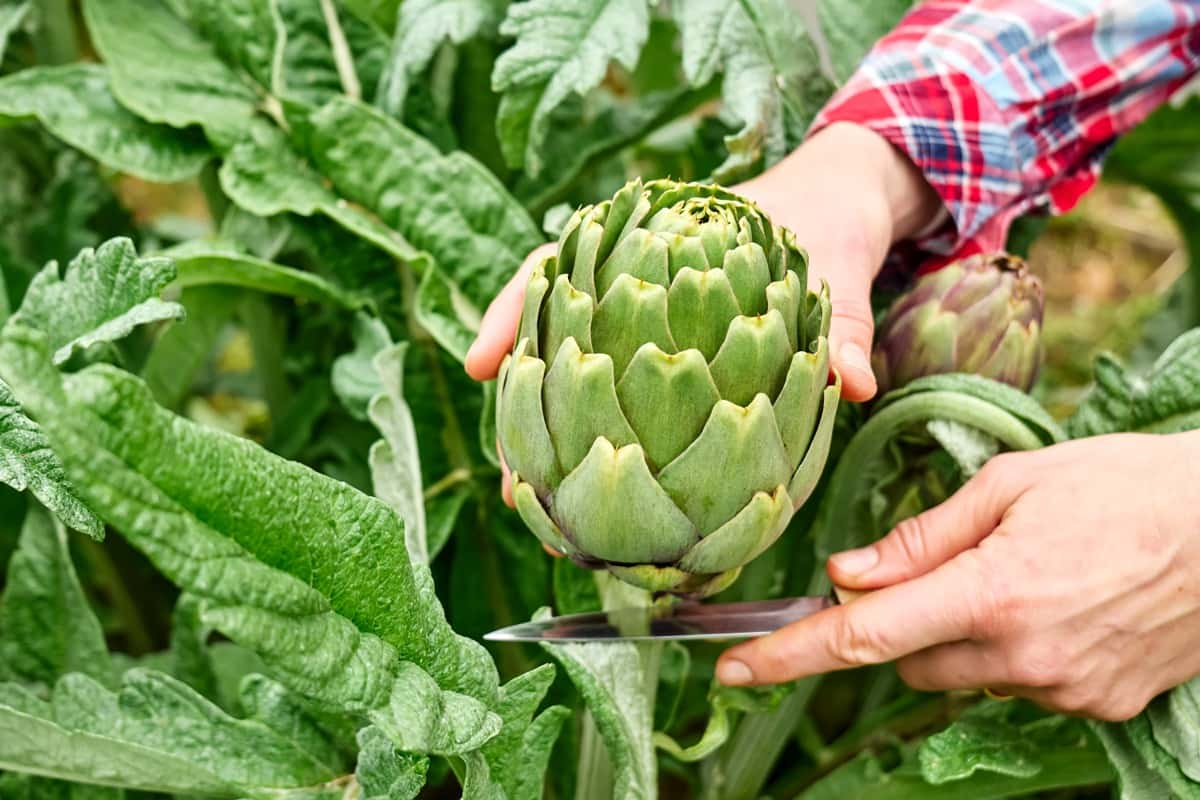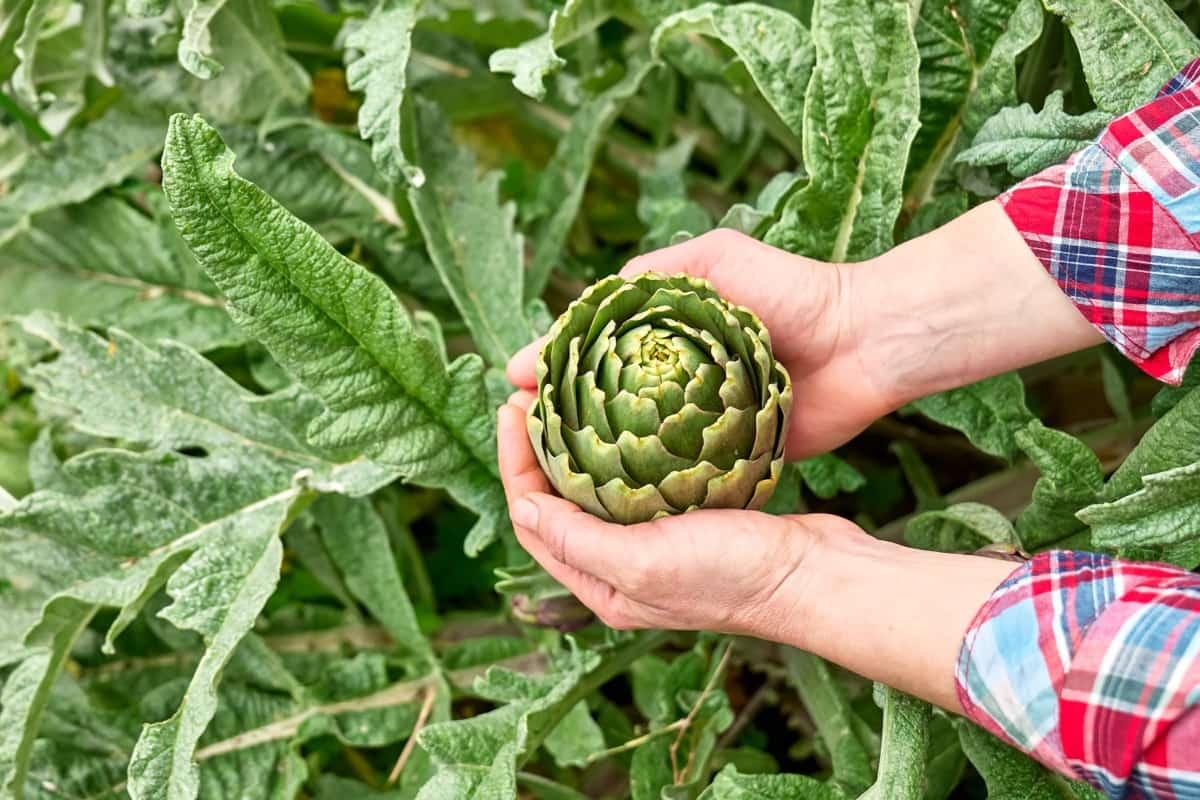Artichokes are a great addition to any garden and are especially well-suited to container gardening. If you live in the region or an area with a short crop growing season, you can start artichokes indoors in pots and then transplant them outside later. This blog post will cover the topics of planting artichokes to the harvesting process.

How to grow and care for Artichokes in containers/pots
12 best Artichoke cultivars to grow in Containers/home garden
| Big Heart Artichoke | Purple Italian Globe |
| Colorado Star | Purple Romagna |
| Emerald | Green Globe Artichoke |
| Castel Artichoke | Tavor |
| Green Globe Improved | Violet de Provence |
| Imperial Star | Violetta di Chioggia |
Can you grow Artichokes from store-bought?
If you’re looking for a unique vegetable in your garden, you may wonder if you can grow artichokes from store-bought. While there are more common ways to start growing artichokes, it is possible. Here’s what you need to know. First, you’ll need to find a healthy artichoke at your local grocery store. Once you have your artichoke, carefully remove any leaves that are attached. These leaves can be used for compost or mulch.
Next, cut off the artichoke’s stem, so you’re left with the base. Now it’s time to plant your artichoke! Fill a pot with well-draining soil and place your artichoke base in the center. Keep the pot moist but not soggy; you should see new growth emerging in a few weeks. Once your plant is a few inches tall, you can fertilize it with an all-purpose fertilizer.
How to choose a container/pot for growing Artichokes
There are certain essential things to consider when selecting a container or pot for growing artichokes. The pot size should be 12 inches deep and 18 inches wide. Artichokes have shallow roots, so a deeper pot is not necessary. A wide pot will allow the roots to spread out and the plant to grow more evenly. Drainage is also essential, as artichokes need to stay moist but not wet. Be sure to select a pot with drainage holes in the bottom. The material of the pot is also important.
In case you missed it: How to Build a Pergola on Terrace: DIY, In Simple Steps for Vine Plants

Artichokes need full sun, so a dark-colored pot will absorb more heat and help keep the roots warm. A light-colored pot will reflect more light and help keep the roots cooler. If you live in a hot climate, choose a light-colored pot to help keep the roots from overheating. If you live in cold climatic zones, choose a dark-colored pot to help keep the roots warm. When it comes to artichokes, more significant is only sometimes better. A larger pot will require more soil, which can lead to problems with drainage. If the pot is too large, the plant may need more water and nutrients.
Best soil to grow Artichokes in containers
Artichokes need well-drained soil so that their roots don’t rot. The second is fertility. Artichokes need fertile soil so that they can produce lots of delicious buds. The third is pH. Artichokes prefer slightly acidic soil with a pH between 6.5 and 7.0. Regarding drainage, there are two schools of thought on the best soil for artichokes in containers. Some experts recommend using a mixture of sand and peat moss to ensure good drainage. Others recommend using a mix of perlite, vermiculite, and composted bark or leaves.
Whichever way you go, ensure that your container has suitable drainage holes so that excess water can escape. You can use a commercial potting mix bought from a garden store or make your own mix at home. If you choose to make your potting mix, add some organic matter to the soil, such as compost or well-rotted manure. This will help provide nutrients for the artichokes as they grow. As for pH, you can test your soil’s pH with a simple kit from the hardware store. If it’s not within the ideal range, you can adjust it by adding some garden lime or sulfur to the soil.
Container soil preparation for growing Artichokes
Before planting artichokes in a container, it is important to prepare the soil. The best type of soil for artichokes is a well-draining, sandy loam. If your soil is a heavy or clay-like texture, you can improve drainage by mixing some organic matter, such as compost or peat moss. Artichokes also require a lot of nutrients, so be sure to add a slow-release fertilizer to the planting hole.
How do you plant Artichokes in a container/pot?
When planting artichokes in pots, it’s important to space them evenly, so they have room to grow. Artichokes can be spaced about 18 inches apart, with each plant having room to spread out about 2 feet. If you’re planting multiple pots of artichokes, make sure to leave enough space between each pot, so the plants have room to spread out.
How and when to water container-grown Artichoke plants
The frequency and amount of water your plants need will vary depending on the size and type of container, the type of soil, the climate, and the time of year. In general, artichoke plants need about 1 inch of water per week. They may need more water during hot weather or when the plants are actively growing. Also, if the leaves start to wilt or the plant looks wilted, it needs more water.
The best way to water container-grown artichoke plants is to soak the soil thoroughly and then allow it to dry out slightly before watering again. This will help prevent root rot and ensure that the plant has enough moisture without being too wet. Check the soil before watering if you need to figure out how often to water your artichokes. If it feels dry several inches below the surface, it’s time to water. It is advised not to overwater your plants, as this can cause root rot disease.
In case you missed it: How to Grow Plants in Grow Bags on Terrace: DIY in Simple Steps

Pests and diseases of Artichokes
| Aphids | Red spider mite |
| Thrips | Powdery mildew |
| Whiteflies | Leaf spot |
| Mealybugs | Stem rot |
Best fertilizers for container-grown Artichokes
Apply a 2-inch layer of compost or manure around the base of the plant every spring. If you are using a commercial fertilizer, choose one high in nitrogen and low in phosphorus. A 10-10-10 fertilizer is also a good option. Check for any other organic fertilizers available in your local garden store.
When to harvest Artichokes from containers?
Artichokes are a notoriously finicky crop, and knowing when to harvest them is crucial to getting a good yield. The ideal time to harvest artichokes is when the buds start to open. If you wait too long, the buds will be challenging and inedible. Conversely, if you harvest too early, the buds will be bigger and more flavorful.
To determine when your artichokes are ready to harvest, carefully inspect the buds. They should be about 6-8 inches in diameter, and the leaves should start to spread apart slightly. Then, gently squeeze the bud; if it feels firm, it’s ready to harvest. If it feels soft or mushy, it’s past its prime.
Conclusion
Artichokes are unique and delicious vegetables that can be grown in containers or pots. They require little care and will produce an abundant crop with little effort. Artichokes are not only beautiful plants, but they are also easy to grow and maintain. With proper planning and care, you can have a bountiful harvest of artichokes from your own container garden.
- Feed Your Flock for Less: Top 10 Tips to Save on Chicken Feed
- Ultimate Guide to Ossabaw Island Hog: Breeding, Raising, Diet, and Care
- Hatching Answers: The Top 10 Reasons Your Chickens Aren’t Laying Eggs
- Eggs and Economics: Breaking Down the Cost of Raising Backyard Chickens
- Defend Your Greens: Proven Methods to Keep Iguanas Out of Your Garden
- Ultimate Guide to Cinnamon Queen Chicken: A Comprehensive Guide for Beginners
- Ultimate Guide to California Tan Chicken: Breeding, Raising, Diet, Egg-Production and Care
- Ultimate Guide to Marsh Daisy Chicken: Breeding, Raising, Diet, and Care
- 10 Types of Chicken Farming Businesses You Can Start for Profits